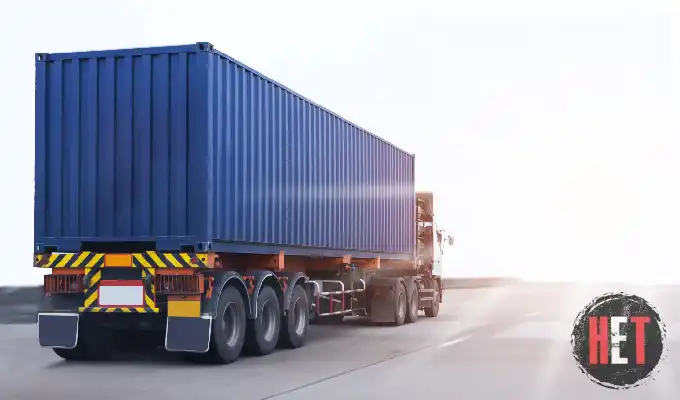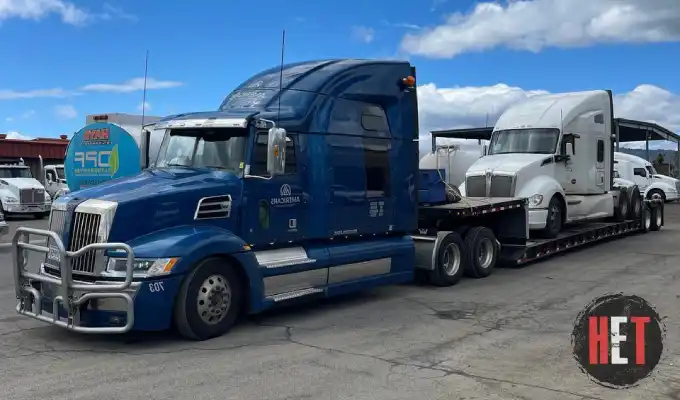DOT COMPLIANCE AND EQUIPMENT SAFETY DURING TRANSPORT
Updated: September 08, 2025
When you’re moving heavy equipment, staying U.S. Department of Transportation (DOT) compliant is essential for safety, legal assurance, and protecting your business’s reputation. You’re responsible not only for ensuring your load is transported without damage, but also for everything that happens while your load is in transit. In this article, you’ll learn what it means to be DOT compliant as it relates to heavy equipment transport, specifically focusing on securement, driver and vehicle qualifications, and handling oversized or hazardous material situations.
You’ll gain clarity on the key rules and practical steps that can protect your assets and keep your operations running smoothly. By the end, you'll understand why choosing a carrier with deep DOT compliance expertise will give you peace of mind.
WHAT DOT COMPLIANCE MEANS FOR YOU
DOT compliance means following the regulations set by the DOT, enforced in heavy-equipment transport by the Federal Motor Carrier Safety Administration (FMCSA). These rules were created to safeguard the public, your drivers, and your equipment across several critical areas.
KEY DOT SAFETY REGULATIONS
- Cargo securement: Equipment weighing 10,000 pounds or more (about 4,536 kg) must be secured with at least four tie-downs to prevent shifting in any direction. Each tie-down needs to be attached as close as possible to the front and rear mounting or vehicle points.
- Driver qualifications and hours of service (HOS): Your drivers must hold a valid Commercial Driver’s License (CDL) and strictly follow hours-of-service rules, such as a maximum of 11 hours drive time within a 14-hour on-duty window, with rest requirements. Beyond hours of service rules, your drivers must meet medical fitness and drug-and-alcohol testing standards. A current DOT medical certificate should confirm satisfactory vision, hearing, and overall fitness. If the certificate has lapsed, a driver can be sidelined immediately. Drug-and-alcohol testing is required pre-employment, at random, post-accident, and upon reasonable suspicion to protect the public, your team, and your transport schedule.
- Vehicle maintenance and inspections: You must keep detailed logs of regular vehicle inspections, repairs, and maintenance to ensure each transport vehicle is in safe mechanical condition. Digital tools such as Electronic Logging Devices (ELDs) and maintenance software are often used to trigger service reminders and link defect corrections to specific units.
- Online DOT registration and DOT number: You will need to distinguish intrastate from interstate transports. Once a load crosses a state line, federal authority applies, so you're required to register for a DOT number, keep your MCS-150 form current (every two years), and stay compliant with filings to avoid jeopardizing your shipments due to an avoidable paperwork lapse.
With a clear understanding of these key regulatory areas, you can effectively evaluate a prospective transport partner. You’ll be able to ascertain which transporters haul equipment with safety, precision, and full regulatory awareness.

SECURING YOUR HEAVY EQUIPMENT PROPERLY
Safe transport begins with how you secure your load. Common securement gaps are predictable — and preventable. Loads shift because chains are routed over sharp edges, anchor points are undersized, or attachments are left partially raised. A sudden lane change, pothole, or hard brake can turn those small errors into equipment damage or a claims dispute.
PRACTICAL TRANSPORT SAFETY GUIDELINES
- Lower and stabilize accessories: Any attachments, like hydraulic shovels or plows, must be fully lowered and locked, or, if raised, securely locked in a transport position.
- Restrain articulated machines: You must prevent any movement between trailer sections or equipment articulation during transit.
- Use rated tie-downs: DOT rules are clear: for equipment over 10,000 pounds, you need a minimum of four tie-downs; think of each as a pillar of stability against lateral, forward, rearward, and vertical shifts. Each tie-down should be rated with a Working Load Limit (WLL), and the combined WLL of your tie-downs must equal at least half the weight of your load. For example, if you’re hauling 30,000 pounds, your tie-downs must secure at least 15,000 pounds total.
- Inspect before and after: Chains, straps, and hardware must be inspected for wear before and after each transport. Damaged or loose components must be replaced immediately to maintain DOT compliance. Brief notes that list the time, location, components inspected, and any adjustments made can serve as proof that you acted responsibly should a claim or dispute arise.
By implementing these practices, you’ll keep your equipment safe and reduce the risk of fines, delays, roadside shutdowns, and damage.
ADDITIONAL TRANSPORT COMPLIANCE CONSIDERATIONS
Beyond basic securement, there are other factors to consider when transporting heavy or oversized loads.
OVERSIZED AND OVERWEIGHT LOADS
Transporting oversized or overweight machinery isn’t as simple as moving standard freight. When your load exceeds standard size or weight limits, "oversized” or “super load” requirements come into play. Specialized trailers, loading equipment, and highly trained operators are often required to get the job done correctly. Weather conditions, uneven terrain, or narrow access points at the delivery site can all complicate the process. Federal limits, such as maximum width (usually 102 inches on major interstates), must be respected and, if exceeded, will require special permits and possibly escorts by pilot cars or police. Some states even restrict oversize transport to daylight hours, while others ban moves during peak traffic, weekends, or holidays. Recognizing these potential hurdles in advance helps carriers prepare the right equipment and support.
Federal limits, such as maximum width (usually 102 inches on major interstates), must be respected and, if exceeded, will require special permits and possibly escorts by pilot cars or police. Some states even restrict oversize transport to daylight hours, while others ban moves during peak traffic, weekends, or holidays. Recognizing these potential hurdles in advance helps carriers prepare the right equipment and support.
HAZARDOUS MATERIALS
If you’re transporting fuel, chemicals, or other hazardous cargo, the Hazardous Materials Transportation Act (HMTA) expands compliance requirements. These materials will need to be properly classified, quantified, and packaged. You’ll also need to keep emergency response information, placards, and crew training current. Any misstep could cause you to face civil or criminal penalties.
FATIGUE AND SCHEDULE MANAGEMENT
One of the most overlooked challenges in heavy equipment transport is driver fatigue. Unlike lighter loads, oversized or overweight cargo demands constant attention. A single lapse in focus can have serious consequences for the driver, the load, and others on the road. Because of the risk to public safety, the DOT takes fatigue-related violations seriously and strictly enforces hours-of-service (HOS) rules.
Effective schedule management is essential so your drivers don’t stay behind the wheel too long. Schedules should allow for rest, proper meal breaks, and flexibility when unexpected delays occur. Fatigue can’t always be measured by the clock; stress, weather conditions, and the act of securing or unloading equipment can drain energy just as quickly as long hours of driving.

BUILDING TRUST THROUGH DOT EXPERTISE
As a business owner, you expect your equipment to arrive safely and legally. Choosing a transport partner who understands DOT regulations is smart risk management.
FATIGUE AND SCHEDULE MANAGEMENT
- Proactive safety planning: They’ll secure your load using tie-downs with sufficient WLL ratings and perform a thorough inspection of chains, straps, and hardware before getting on the road.
- Compliance documentation: Their drivers adhere to HOS rules, hold a valid CDL, meet clean-record standards, and their vehicle maintenance logs are thorough and accurate enough to stand up to DOT roadside inspections or audits.
- Regulatory oversight: They relieve you of having to manage permits and paperwork for oversized loads and hazardous materials, and they ensure that your MCS-150 filings are up-to-date.
A trusted carrier partner knows that you want the reassurance of having compliance built into the service offering. Freeing you to focus on your core operations is top of mind. What to look for? Higher-than-minimum liability and cargo limits, up-to-date operating authority, strong CSA scores, transparent documentation, and responsive safety staff indicate a culture that treats compliance as a daily habit.
CONCLUSION
Transporting heavy equipment safely and lawfully means weaving DOT compliance into every mile. When compliance is routine, you gain predictability — fewer surprises, fewer delays, and fewer headaches. That steadiness lets you plan confidently, protect profit margins, and keep projects on schedule.
You deserve a carrier that knows that tie-down counts, WLL ratings, driver hours, and regulatory logistics are integral to your business’s reliability.
When you choose to work with Heavy Equipment Transport, you’re choosing a team that knows federal rules inside and out and integrates that expertise into every shipment. We don’t just move your equipment — we do it with accountability, consistency, and DOT precision.
Contact us today to discuss your next move. We help you navigate compliance with ease, so you can rest easy knowing your equipment and reputation are in capable, dependable hands.


